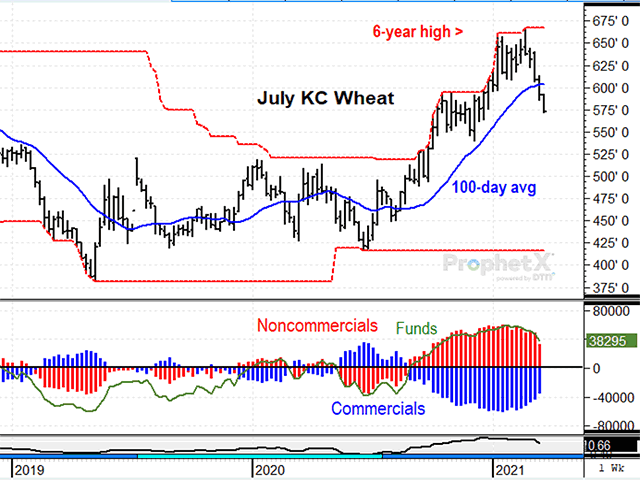Todd's Take
A Bearish Break in KC Wheat
Just over a week ago, on March 18, July KC wheat fell to a new two-month low and closed below its 100-day average for the first time since late-August, a clear, bearish change in trend. The turn ended a six-and-a-half-month rally that saw prices gain over $2 per bushel on the heels of a growing season that offered no bullish hope when the rally began in late August.
According to USDA's latest estimates, the 2020-21 season saw world wheat production hit a new record high of 776.78 million metric tons (mmt) or 28.54 billion bushels (bb) and world ending wheat stocks reach a new record of 301.19 mmt or 11.07 bb. Looking back, winter wheat prices started climbing higher when planting conditions in the U.S. turned dry in September and also found support from reports of the driest fall conditions in southern Russia in 30 years.
Despite bearish world wheat estimates, we noted in DTN's October World Agricultural Supply and Demand Estimates (WASDE) webinar that ending hard red winter (HRW) wheat stocks fell to their lowest level in five years. The December/March KC wheat spread was also narrowing, an important clue the market was becoming less bearish in its opinion of KC wheat prices.
The other interesting clue was that, even though KC wheat prices were challenging one-year highs by mid-September, large speculators were slow to jump on the bullish bandwagon. The early stages of the wheat rally came largely from genuine demand, the most bullish of all the market clues.
On Sept. 25, 2020, I wrote, "HRW wheat prices should have opportunities to trade higher this winter, especially if dry concerns persist." Boy, did they. KC wheat prices overcame whatever fundamental reluctance the market had and trended solidly higher, right up to the $6.67 peak in the July contract on Feb. 24.
We can't overlook that there was some ridicule for wheat prices along the way. Many talked as if the corn rally was the only bullish reason wheat was trading higher. Yes, the bull market in corn was an important influence and still is today, but corn's success didn't explain the whole wheat story. Talk of Russia raising export taxes lent some support and futures spreads in KC wheat showed signs of bullish winter demand, especially in late January.
P[L1] D[0x0] M[300x250] OOP[F] ADUNIT[] T[]
February brought an especially harsh cold snap to the southwestern U.S. Plains and it seemed likely that at least some damage had been done to dormant winter crops. The $6.67 high on Feb. 24 benefited from those concerns and was the highest price a July KC wheat contract had seen in six years.
As prices traded lower the next morning, I decided it was time for DTN's Six Factors Market Strategies to recommend selling the final 25% of winter wheat production. Now, spot KC wheat is roughly 70 cents lower. I can't deny some luck was involved, but the credit goes largely to the discipline of DTN's Six Factors approach and the way it forces us to look at the market from different views.
At the time, the trend was up but slowly losing momentum while three-month price volatility was narrowing. Noncommercials were significantly net long but had shown signs of liquidating. The May/July KC wheat spread showed a significant decline in demand for the front month in February. Finally, prices were challenging a six-year high at a time of year when the season was about to change. We had waited all winter to see what spring conditions would be like, and we were at a time of year where we were about to find out.
I recently listened to an interview of the Princeton psychologist Daniel Kahneman, winner of the 2002 Nobel Prize for Economic Sciences
(interviewed by Shane Parrish at the Farnam Street blog: https://fs.blog/…). Kahneman was talking about how to make good decisions.
He explained that you want to break the decision into dimensions and evaluate each dimension independently. Only after doing that do you want to consider the whole profile and make the decision. The key, he said, is to "delay your intuition." We normally form intuitions too quickly and that is where we go wrong.
It struck me that Kahneman described the same process DTN uses when writing its Six Factors, and it has served customers well. No, it's not perfect and doesn't mean we can predict the future. Like many, I can point to corn and soybean sales made too early in 2020. But the process has been sound and has often put us in position to be lucky as we were on the recent recommendation to sell KC wheat.
So, where does KC wheat go from here? For the foreseeable future, the outlook looks bearish as winter wheat crop conditions are looking good in Europe and Ukraine; even southern Russia appears to have benefited from increased moisture over the winter.
On Thursday, the International Grains Council estimated world wheat production will be up 2% in 2021-22 to a new record high 790 mmt or 29.03 bb. There is plenty of uncertainty yet in the new season, however. Here in the U.S., the forecast looks mostly dry for the central and western U.S. Plains the next seven days, followed by an April forecast that looks mostly dry for the southwestern U.S. Plains.
Technically, KC wheat looks bearish at the moment, but Friday's Commitments of Traders report is likely to show a significant drop in noncommercial net longs. With corn prices holding well above $5.00 and prospects for drier weather ahead, I suspect spot KC wheat prices will find support somewhere above $5.00 -- down from the February high, but higher than KC wheat prices have seen the past couple years.
Todd Hultman can be reached at Todd.Hultman@dtn.com
Follow him on Twitter @ToddHultman1
(c) Copyright 2021 DTN, LLC. All rights reserved.




